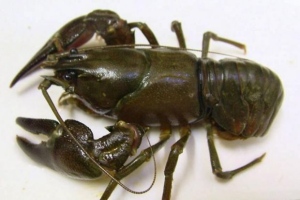![]()
![]()

Foreign invader on the march despite net loss of one million
April 18, 2010
 American signal crayfish are an increasing problem in Scottish waters
American signal crayfish are an increasing problem in Scottish waters
They are the scourge of Scotlandfs rivers, an aggressive foreign invader that plays havoc with local fauna and fish stocks.
But a Scottish Government scheme that trapped and killed more than a million American signal crayfish in just four months may actually have done more harm than good, a Glasgow University researcher has warned.
Biologist Zara Gladman surveyed populations of the predatory crustacean in its Scottish stronghold of Loch Ken in Dumfries and Galloway both during and after the four-month initiative.
Although the publicly funded programme netted more than a million ?of the species, which has been classed as a pest since being accidentally introduced to the wild in the 1980s, Ms Gladman said there was no sign their numbers had been significantly reduced.
She added it has the opposite effect because as trapping tends to catch larger, more mature specimens, it can actually reduce competition for young crayfish and allow them to breed even more ferociously than before.
Dave Paterson, proprietor of the Ken Bridge Hotel on the banks of the loch, near Castle Douglas, described the crayfish as ga menaceh.
gThe loch is an incredibly important revenue stream for many businesses,h he said.
gIf youfre getting large groups of fishermen not coming to the loch, thatfs going to seriously impact on hotels, bait shops, and the wider infrastructure in what is really a very rural area.h
The study conservatively estimated there were nine American signal crayfish per square metre through much of the nine-mile long loch, a figure not significantly dented by the four-month catch-and-kill campaign that ran from June to October last year.
The Scottish Environment Protection Agency said at the time that trapping was unlikely to be a long-term solution, but hopes of a breakthrough were raised briefly when one million of the creatures were caught in such a short time.
Anglers and marine organisations now fear that the signal crayfish could have an unshakable hold on Scotlandfs waterways, and authorities are at a loss over how to get rid of them.
Leading chefs, including Gordon Ramsay and River Cottagefs Hugh Fearnley Whittingstal, have produced recipes for the signal crayfish, while environmentalist George Monbiot has also advocated fishing for the six-inch crustacean, which is easily trapped with a home-made net and provides a cheap alternative to lobster.
Ms Gladman said a growing public appetite for crayfish could be harmful because it could encourage more illegal cultivation.
The American signal crayfish can cross wide stretches of land in search of new territory, and there are fears they could easily escape from tanks or ponds if people begin storing them.
Anyone hoping to trap wild crayfish also risks falling foul of strict environmental laws.
Last week a man in England was fined 4,000 for trapping crayfish without a licence from the Environment Protection Agency, and for inadvertently catching the wrong type ? a vulnerable native species.
The foreign species was first introduced to the UK because of its resistance to a fungus that wrecked stocks of European crayfish in the 1970s, but they soon established themselves
and came to dominate local habitats.They grow to twice the size of the local white clawed crayfish, and can outcompete other species ? including young salmon ? for food and shelter.
Though the white clawed crayfish is not native to Scotland either, other species are suffering as a result of the spread of the American signal crayfish.
The only control method that has shown any promise is large-scale poisoning, Ms Gladman said, gbut in a big river like the Clyde, or in a big loch, thatfs just not feasibleh.
The signal crayfish are now spreading rapidly along the Clyde, from a hotspot around Elphinstone.
A Glasgow University study tagged and tracked a number of specimens and found some moving upstream at a rate of several hundred metres in just a few days.
gTheyfre here to stay, and it may never be possible
to eradicate themh, said Ms Gladman.
Back to
Crayfish News!